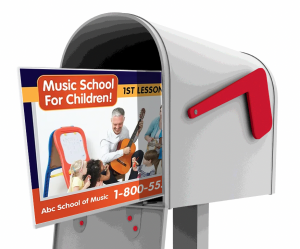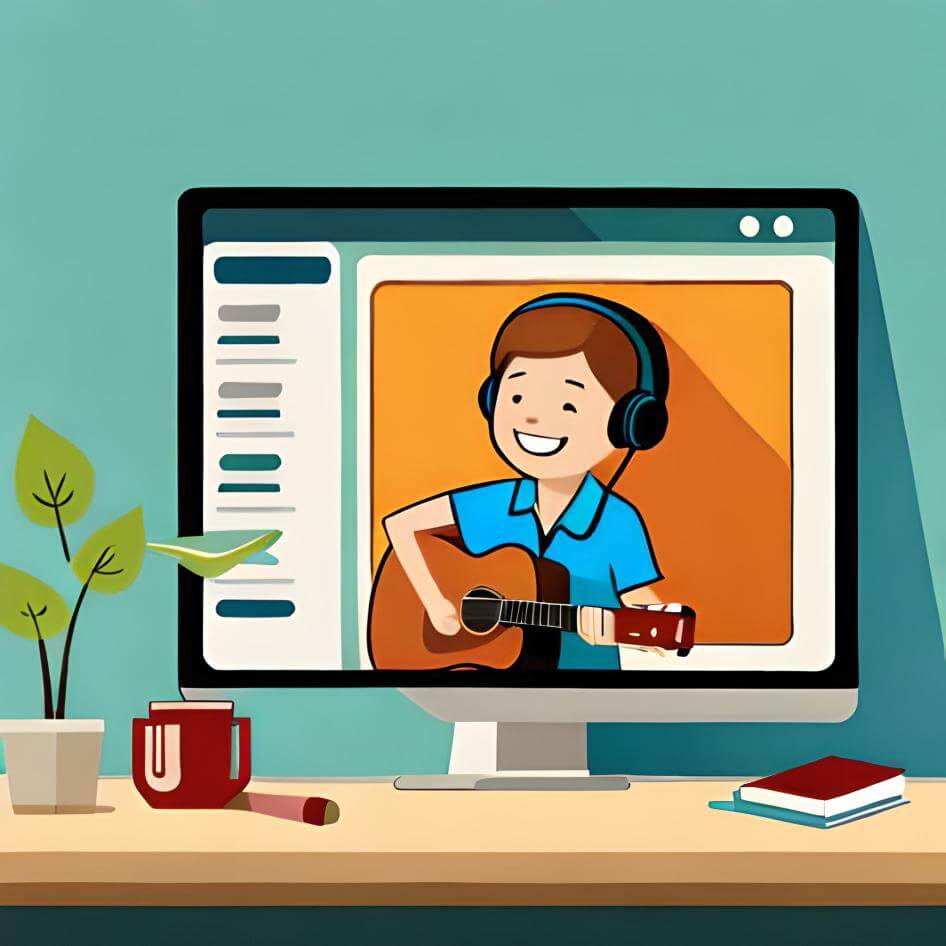 Marketing your services as a private music teacher is essential to growing your studio and attracting new students. With the rise of digital marketing, it’s easy to overlook traditional marketing methods such as direct mail. But done right, direct mail can be a highly effective way to reach potential students and generate new business.
Marketing your services as a private music teacher is essential to growing your studio and attracting new students. With the rise of digital marketing, it’s easy to overlook traditional marketing methods such as direct mail. But done right, direct mail can be a highly effective way to reach potential students and generate new business.
Direct mail refers to sending physical mail, such as postcards or brochures, directly to a targeted list of potential music students. In this article, we’ll explore the benefits of using direct mail for private music teachers and provide a step-by-step guide on effectively implementing a direct mail campaign. From understanding your target audience to measuring the success of your campaign, we’ll cover what you need to know to get started. Direct mail is a way of reaching out to potential music students who are not actively searching for music lessons, unlike strategies such as Google AdWords or Search Engine Optimization, which only work when a potential student is already seeking a music teacher. Direct mail serves as a proactive approach, similar to a billboard, in that it makes a potential student aware of a need they may not have been aware of before.
So, if you’re looking for a cost-effective and targeted way to grow your music lesson business, read on to learn how direct mail can help.
General Direct Mail Facts and Statistics
Here are some compelling facts and statistics that demonstrate the effectiveness of direct mail:
- Response rates: Direct mail response rates are typically higher than those of other marketing channels, such as email or online advertising. According to the Direct Marketing Association (DMA), the average response rate for direct mail is 4.4%, compared to just 0.12% for email.
- Targeted campaigns: Targeted direct mail campaigns, which are tailored to specific demographics or interests, can have even higher response rates. For example, targeted campaigns to households with high-income levels, households with children between the ages of five and ten, or a specific interest in music can have up to 7% response rates.
- Long-term impact: Direct mail can have a long-lasting impact on its recipients, allowing you to create a tangible and memorable connection with your target audience. According to a study by the Royal Mail, 84% of people said they keep direct mail for future reference.
- Cost-effectiveness: Direct mail tends to be a cost-effective marketing option. It’s possible to reach hundreds of potential students in a highly targeted area for just a few hundred dollars.

Do you want to get more students and grow your music teaching business?
MusicTeacherNotes is music teacher software that helps music teachers get more students and manage all aspects of their music teaching business! Every teacher who registers for a free account gets a Music Teacher Directory listing, even if they never upgrade. There is no risk in joining.
Just how much does direct mail cost?
The cost-effectiveness of a direct mail campaign depends on various factors. However, it is expected that one or two new students generated through the campaign would cover its cost, with any additional students being a profit. The video The Youtube video, “Marketing Music Lessons: Avalon School of Music,” features a music teacher who utilizes PostcardMania to manage his direct mail campaigns.
Obviously, your results depend on several factors:
- How good was the mailing list or EDDM mailing route?
- Did the cards have sufficient quality to project a professional image?
- How compelling was your message?
- Did you effectively close the sale when potential students contacted you?
Understanding your target audience
Identifying potential students
To start, consider who your ideal student might be. By defining your target demographic, you can begin to build a picture of who you want to reach with your direct mail campaign. You’ll want to consider location, age, income, homeownership status, and more specific information, such as whether they have children or if they’ve expressed an interest in music.
You essentially have three options when choosing how to send your direct mail postcards.
- Purchasing a mailing list: You can purchase a mailing list from a reputable provider specializing in direct mail lists. These lists are often pre-screened and sorted based on your target demographic criteria.
- Compiling your own list: If you already have a database of existing or past students, you can use this as a starting point for your direct mail campaign. You can also gather information from public records or ask new students to provide their contact information.
-
EDDM (Every Door Direct Mail): EDDM is a service offered by the United States Postal Service (USPS) that allows businesses to send marketing mail pieces to every household (every door) on a specific postal carrier route without the need for a mailing list or individual addresses. EDDM is a cost-effective solution to reach a large number of people in a specific geographic area without the cost of purchasing or maintaining a mailing list. While the cost per mailing is cheaper, and you don’t need a list, you will send more cards. For that reason, consider the cost per card when you choose this method. Plan to send the same postcards to the same households repeatedly on the mail routes you select.
Choosing between a targeted mailing list or EDDM (Every Door Direct Mail)
A highly targeted mailing list is more effective for a direct mail campaign but comes with a higher cost. It’s important to remember that a targeted mailing list is only valid for a short time as people move and children grow older. For example, if your list targets families with children between the ages of 5 and 10, its effectiveness will decrease in just a few years as the children age and people move.
On the other hand, Every Door Direct Mail (EDDM) is an affordable option that reaches every household along a selected mailing route. When using EDDM, you can choose routes with a high concentration of your target market, and you don’t have to maintain a mailing list. With EDDM, the mailing route remains unchanged, although the recipients on that route might change significantly. For example, you may reach a new family recently moving into the area. These new residents may keep your EDDM postcards for years until their children are of age to take music lessons. As one expert stated, it’s better to market to 1000 people ten times than 10,000 people one time.
If you decide to pursue an EDDM campaign for your music school, you’ll probably have several questions. The Youtube video, “How to do an EDDM Mailing ~ The Easy Way,” will save you a lot of time and help you better understand how EDDM works.
Defining the target demographic
To define your target demographic, consider the following factors:
- Age: Are you targeting young children, teenagers, or adults?
- Location: Are you looking to reach potential students in a specific area, such as a particular city or neighborhood?
- Income: Are you targeting families with disposable income?
- Interests: Are you targeting individuals with specific interests, such as piano, guitar, drums, saxophone, or voice lessons?
Considering these factors, you can build a picture of your ideal student and tailor your message to appeal to them.
For example, if you’re targeting young children and their families, your message might focus on the benefits of starting music lessons at a young age and the benefits of music lessons for children. If you’re targeting adults, your message might focus on the benefits of learning a new skill and the sense of accomplishment that comes with it.
It’s important to note that your target demographic will likely change depending on the problem you’re attempting to solve. Continually review and refine your demographic information to ensure that your direct mail campaigns remain effective.
Designing your direct mail piece: The importance of solid design
Designing your direct mail piece is crucial in making a lasting impression on your potential students and their families. A strong and visually appealing design can grab their attention and make them more likely to engage with your message. This section will cover essential elements to consider when designing your direct mail piece, such as choosing the suitable format, creating an eye-catching design, and including a clear call-to-action. Investing in your piece’s design will increase its chances of success and help grow your music lesson business.
Postcard quality
The quality of your direct mail postcard is an important factor to consider. The following elements matter when it comes to the quality of a direct mail piece:
- Printing Quality: The printing quality should be clear and sharp, with vibrant colors and crisp text. Poor printing quality can detract from the message and may not grab the recipient’s attention.
- Card Stock: The card stock should be sturdy enough to hold up during the mailing process and also provide a professional look and feel.
- Design: The design should be eye-catching and appealing, with a clear and easy-to-read layout. It should also effectively communicate the message and convey the desired image for your business.
- Size: The size should be appropriate for the message and target audience, and it should also be compliant with postal regulations.
Your postcard’s message
Think of the problem you are trying to solve as a music teacher. You might not think of your role as a private music teacher as solving a problem, but you are. All successful businesses solve a problem for a customer. Mcdonald’s solves the problem of finding something to eat quickly at a reasonable price. A jewelry store solves the problem of finding an engagement ring that someone’s fiancé will love. Yes, businesses solve multiple problems, but your message can only focus on one at a time. As a music teacher, you solve many problems, including:
- Difficulty finding a qualified teacher: Many people struggle to find a music teacher who is qualified, experienced, and a good fit for their needs and goals.
- Lack of musical skills or confidence: Many individuals want to learn to play an instrument but may feel intimidated or lack the necessary skills to get started.
- Inefficient or ineffective lessons: Some people may have had negative experiences with music lessons in the past, either due to a lack of personalized attention or poor teaching methods.
- Limited access to quality music programs: Some individuals may live in areas without access to quality music programs or affordable private lessons.
- Cost: Private music lessons can be expensive, and many families may not have the budget to support them.
- Difficulty fitting lessons into a busy schedule: Many families have busy schedules, and finding time for weekly music lessons can be challenging.
- Lack of motivation: Some individuals may struggle with motivation and discipline when it comes to practicing and improving their musical skills.
- Limited exposure to different musical styles: Some individuals may want to explore different musical genres but may not have access to them through their current lessons or programs.
- Difficulty finding the right type of instrument: Some individuals may not be sure which instrument they want to learn, or they may not have access to the instruments they are interested in.
- Uninspiring lessons: Some individuals may have had experiences with music teachers who lack enthusiasm or creativity in their lessons, making the learning process uninteresting or unengaging.
When creating your direct mail piece, you must pick a specific problem. You don’t want to try to cram all of the problems with their solutions into one mailing. Doing so will overwhelm the recipient and reduce the effectiveness of your campaign. This marketing approach comes from the book, The Brain Audit, by Sean D’Souza, a popular marketing book that provides a practical framework for understanding why customers make purchasing decisions and how to use this knowledge to increase sales and build a more successful business. The gist of the book is that a marketing campaign has to proceed in a specific order:
- No. 1: The Target Profile (The Trigger)
- No. 2: The Problem
- No. 3: The Solution
- No. 4: The Objections
- No. 5: The Testimonials
- No. 6: The Risk Reversal
- No. 7: The Uniqueness
This article won’t get into detail about the book, but think of this sequence from the Brain Audit as you create your direct mail campaign.
For example, if you want to implement the concepts from the Brain Audit into your postcard, think of the problem you intend to address, then flip the problem to provide your solution.
- Problem: Are you frustrated by inefficient piano lessons?
- Solution: We will make you a much better piano player, quickly and efficiently.
- Problem: Do your children struggle with motivation when practicing piano?
- Solution: I will teach your child piano and help motivate them to practice like they never have before!
- Problem: Do you struggle to find piano lessons that fit your busy schedule?
- Solution: We offer piano lessons that work with the busiest of schedules.
Notice that the solutions do not delve into how the problems get solved. They merely flip the problem to create the solution and make the recipient wonder, “How?” Read the Brain Audit to see why this is so powerful.
Include a Call-to-Action
Finally, include a clear and compelling call to action in your direct mail piece. Encourage potential students and their parents to take action, whether calling you directly, visiting your website, or, assuming you have a MusicTeacherNotes account, going to the MusicTeacherNotes Availability Calendar to review lesson openings and request a lesson. Your call-to-action should be easy to spot and prompt the recipient to take immediate action.
Sending your Direct Mail Campaign
The final step in using direct mail to promote your music lesson business is to send out your direct mail campaign. In this section, we’ll discuss important factors to consider when determining the frequency of your mailings, timing your mailings for maximum effectiveness, and evaluating the success of your campaign.
Determining the Frequency of Mailings
When it comes to direct mail, the frequency of mailings is an essential factor in the success of your campaign. Some music teachers may opt to send a monthly mailing to keep their lessons at the top of their potential customers’ minds, while others may opt for a bi-annual mailing to save on printing and postage costs. The frequency of your mailings will depend on your budget, target audience, and the goals of your campaign. It’s important to remember that direct mail is not a one-time event. Remember again that it is better to send to 1000 people ten times than to 10,000 people one time. Repeatedly mailing the same postcard to the same people makes it harder for potential students to ignore, especially if the postcard contains an offer that resonates with them.
Timing Your Mailings for Maximum Impact
Timing depends on the type of problem you are trying to solve. If you are trying to solve the problem of parents seeking piano lessons for their children, a popular time to send out direct mail for music lessons is in the summer, before school starts, or just before New Year’s Day, as kids prepare to return to school after winter break. On the other hand, if you’re targeting parents looking for summer activities, you may want to send your mailings during the late spring and early summer months. As a music teacher, you may already know when you want to fill your schedule. Just understand that timing matters a lot when it comes to direct mail. The key is understanding your target audience and when they most likely need your services.
Measuring the Success of Your Campaign
Finally, it’s crucial to track the success of your direct mail campaign so you can make adjustments for future mailings. This can be done by using unique coupon codes or tracking the number of new students who sign up for lessons after receiving your mailing. This information can help you determine the most effective mailing frequency, design, and messaging for your target audience. Over time, you can continue to grow your music lesson business by continually measuring and improving your direct mail campaign.
Final thoughts
Direct mail is a highly effective marketing tool for private music teachers looking to reach potential students and grow their businesses. With response rates that are often higher than other marketing channels, and the ability to create a tangible and memorable connection with your target audience, direct mail is a cost-effective way to generate new business. By understanding your target audience, identifying potential students, and creating a targeted direct mail campaign, you can effectively reach your audience and see a return on investment. Direct mail campaigns can be tracked and measured to help ensure that your marketing efforts are paying off. With its proven effectiveness, private music teachers should consider direct mail as part of their overall marketing strategy.

 Do you want to get more students and grow your music teaching business?
Do you want to get more students and grow your music teaching business?